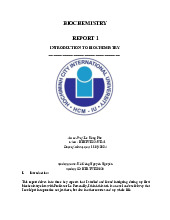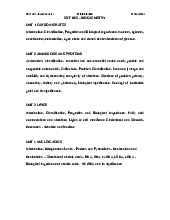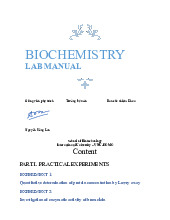




















Preview text:
lOMoAR cPSD| 36490632
Citric Acid cycle or Tricarboxylic Acid cycle or Krebs Cycle
Overview and brief history
Pyruvate Dehydrogenase Complex (PDC) and its control
Reactions of TCA cycle or CAC
Amphibolic nature of TCA cycle
Regulation of TCA cycle
Reactions of Glycolysis are localized in Cytosol, and do not require any oxygen.
whereas pyruvate dehydrogenase and TCA cycle reactions take place in
mitochondria where oxygen is utilized to generate ATP by oxydative phosphorylation.
Consumption of oxygen (respiration) depends on the rate of PDC and TCA reactions. lOMoAR cPSD| 36490632 In Cytosol
In Mitochondria lOMoAR cPSD| 36490632
Historical perspective:
1930: Elucidation of Glycolysis
Study of oxidation of glucose in muscle, addition of
Malonate inhibited the respiration (i.e. O2 uptake).
Malonate is an inhibitor of Succinate oxidation to Fumerate
1935: Szent‐Gyorgyi: demonstrated that little amounts
(catalytic amounts) of succinate, fumerate, malate or
oxaloacetate acelerated the rate of respiration.
He also showed the sequence of inter‐conversion:
Succinate ‐‐‐ Fumerate ‐‐‐ malate ‐‐‐oxaloacetate.
1936: Martius & Knoop: Found the following sequence of reaction:
Citrate to cis‐aconitase to Isocitrate to a Ketogluterate to succinate
1937: Krebs: Enzymatic conversion of Pyruvate + Oxaloacetate to citrate and CO2
Discovered the cycle of these reactions and found it to be a major pathway for pyruvate oxidation in muscle. lOMoAR cPSD| 36490632
Reaction of pyruvate dehydrogenase complex (PDC)
Reactions of TCA cycle: 8 reactions: Citrate synthase Aconitase
Iso‐citrate dehydrogenase
ketoglutarate dehydrogenase
Succinyl‐Coenzyme A synthetase
Succinate dehydrogenase Fumerase Malate dehydrogenase lOMoAR cPSD| 36490632 lOMoAR cPSD| 36490632
Pyruvate dehydrogenase Complex (PDC)
It is a multi‐enzyme complex containing three enzymes associated together noncovalently:
E‐1 : Pyruvate dehydrogenase , uses Thiamine pyrophosphate as cofactor bound to E1
E‐2 : Dihydrolipoyl transacetylase, Lipoic acid bound, CoA as substrate E‐
3 : Dihydrolipoyl Dehydrogenase
FAD bound, NAD+ as substrate
Advantages of multienzyme complex:
1. Higher rate of reaction: Because product of one enzyme acts as a substrate of
other, and is available for the active site of next enzyme without much diffusion.
2. Minimum side reaction.
3. Coordinated control. lOMoAR cPSD| 36490632
Thiamin (Vitamine B1) deficiency causes Beriberi:
Thiamine pyrophosphate (TPP) is an important cofactor of pyruvate dehydrogenase complex,
or PDC a critical enzyme in glucose metabolism. Thiamine is neither synthesized nor stored in
good amounts by most vertebrates. It is required in the diets of most vertebrates. Thiamine
deficiency ultimately causes a fatal disease called Beriberi characterized by neurological lOMoAR cPSD| 36490632
disturbances, paralysis, atrophy of limbs and cardiac failure. Note that brain exclusively uses
aerobic glucose catabolism for energy and PDC is very critical for aerobic catabolism.
Therefore thiamine deficiency causes severe neurological symptoms.
Arsenic Poisoning: Arsenic compounds such as arsenite (AsO3‐‐‐) organic arsenicals are
poisonous because they covalently bind to sulfhydryl compounds (SH‐ groups of proteins and
cofactors). Dihydrolipoamide is a critical cofactor of PDC, and it has two‐SH groups, which are
important for the PDC reaction. These –SH groups are covalently inactivated by arsenic compounds as shown below; OH HS S ‐O As + ‐O As + 2H2O OH S HS R R
Arsenic compounds in low doses are very toxic to microorganisms, therefore these
compounds were used for the treatment of syphilis and other diseases in earlier
days. Arsenicals were first antibiotics, but with a terrible side effects as they are
eventually very toxic to humans.
Unfortunately and ignorantly, a common nineteenth century tonic, the Fowler’s
solution contained 10 mg/ml arsenite. This tonic must have been responsible for
many deaths, including the death of the famous evolution scientist Charlse Darwin. lOMoAR cPSD| 36490632
Arsenic Compound poisoning: Inactivation of E‐2 of PDC, and other proteins.
Organic Arsenical were used as
antibiotics for the treatment of
syphilis and trypanosomiasis.
Micro‐organisms are more
sensitive to organic arsenicals than humans. But these compounds had severe side effects and As‐ poisoning.
Fowler’s solution, the famous
19th century tonic contained 10mg/ml As. Charles Darwin
died of As poisoning by taking this tonic.
Napoleon Bonaparte’s death
was also suspected to be due to As poisoning.
Reactions of Citric Acid Cycle
1. Citrate synthase: Formation of Citroyl CoA intermediate. lOMoAR cPSD| 36490632
2. Binding of Oxaloacetate to the enzyme results in conformational change
which facilitates the binding of the next substrate, the acetyl Coenzyme A.
There is a further conformational change which leads to formation of
products. This mechanism of reaction is referred as induced fit model.
2. Aconitase: This enzyme catalyses the isomerization reaction by removing and
then adding back the water ( H and OH ) to cis‐aconitate in at different positions.
Isocitrate is consumed rapidly by the next step thus deriving the reaction in forward direction. lOMoAR cPSD| 36490632
3. Isocitrate dehydrogenase: There are two isoforms of this enzyme, one uses
NAD+ and other uses NADP+ as electron acceptor. lOMoAR cPSD| 36490632 4.
‐Ketoglutarate dehydrogenase: This is a complex of different enzymatic
activities similar to the pyruvate dyhdogenase complex. It has the same
mechanism of reaction with E1, E2 and E3 enzyme units. NAD+ is an electron acceptor. lOMoAR cPSD| 36490632
5. Succinyl CoA synthatse: Sccinyl CoA, like Acetyl CoA has a thioester bond with
very negative free energy of hydrolysis. In this reaction, the hydrolysis of the
thioester bond leads to the formation of phosphoester bond with inorganic
phosphate. This phosphate is transferred to Histidine residue of the enzyme and
this high energy, unstable phosphate is finally transferred to GDP resulting in the generation of GTP. lOMoAR cPSD| 36490632
6. Succinate Dehydrogenase: Oxidation of succinate to fumarate. This is the only
citric acid cycle enzyme that is tightly bound to the inner mitochondrial membrane.
It is an FAD dependent enzyme.
Malonate has similar structure to Succinate, and it competitively inhibits SDH. lOMoAR cPSD| 36490632
7. Fumarase: Hydration of Fumarate to malate: It is a highly stereospecific
enzyme. Cis‐Maleate (the cis form of fumarate is not recognized by this enzyme. lOMoAR cPSD| 36490632
8. L‐Malate dehydrogenase: Oxidation of malate to oxaloacetate: It is an
NAD+dependent enzyme. Reaction is pulled in forward direction by the next
reaction (citrate synthase reaction) as the oxaloacetate is depleted at a very fast rate. lOMoAR cPSD| 36490632
Conservation of energy of oxidation in the CAC: The two carbon acetyl group
generated in PDC reaction enter the CAC, and two molecules of CO2 are released in on
cycle. Thus there is complete oxidation of two carbons during one cycle. Although the two
carbons which enter the cycle become the part of oxaloacetate, and are released as CO2
only in the third round of the cycle. The energy released due to this oxidation is conserved
in the reduction of 3 NAD+, 1 FAD molecule and synthesis of one GTP molecule which is converted to ATP. lOMoAR cPSD| 36490632
Efficiency of Biochemical engine in Living Systems:
Oxidation of one glucose yields 2840 kJ/mole energy
Energy obtained by biological engine: 32ATP X 30.5 kJ/Mol = 976 kJ/mol Thus
34% efficiency is obtained if calculations are done using standard conditions.
But if concentrations in the cellular condition are taken in account, the
efficiency is close to 65%. lOMoAR cPSD| 36490632
The amphibolic nature of Citric acid cycle: This pathway is utilized for the both
catabolic reactions to generate energy as well as for anabolic reactions to generate
metabolic intermediates for biosynthesis.
If the CAC intermediate are used for synthetic reactions, they are replenished by anaplerotic
reactions in the cells (indicated by red colours). lOMoAR cPSD| 36490632 Regulation of CAC: lOMoAR cPSD| 36490632
Rate controlling enzymes: Citrate synthatase
Isocitrate dehydrogenase
‐keoglutaratedehydrogenase
Regulation of activity by: Substrate availability Product inhibition
Allosteric inhibition or activation by other intermediates
Document Outline
- Citric Acid cycle or Tricarboxylic Acid cycle or Krebs Cycle Overview and brief history
- Pyruvate dehydrogenase Complex (PDC)




